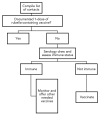Congenital rubella syndrome, a case series
- PMID: 39170592
- PMCID: PMC11323722
- DOI: 10.14745/ccdr.v50i78a05
Congenital rubella syndrome, a case series
Abstract
Rubella, or German measles, is a vaccine-preventable disease. Rubella infection is usually mild; however, infection in pregnancy is associated with severe outcomes for the baby, including pregnancy loss or a combination of developmental defects called congenital rubella syndrome. Within the last ten-year period, two cases of congenital rubella syndrome in Saskatchewan were reported to the provincial ministry and the Public Health Agency of Canada of the newborns of mothers who had recently arrived from Sub-Saharan Africa. Both infants had multiple health complications at birth consistent with congenital rubella and tested positive for the rubella virus. The article discusses the challenges encountered by the healthcare system in diagnosing, investigating, monitoring and managing cases of congenital rubella syndrome to prevent further sporadic transmission. The article emphasizes the need to provide additional support for cases and their households, especially new Canadians with less support to comply with public health advice and the importance of routine immunization to eliminate rubella globally.
Keywords: Canada; congenital rubella syndrome; immigration; public health management; risk mitigation.
Conflict of interest statement
Competing interests All authors have completed and submitted the International Committee of Medical Journal Editors form for disclosure of potential conflicts of interest. JM reports receiving grants from the Public Health Agency of Canada (PHAC), Saskatchewan Health Research Foundation (SHRF) and Canadian Institutes of Health Research (CIHR) paid to collaborating academic institutions.
Figures
References
-
- Durowade KA, Musa OI, Jimoh MA, Salaudeen AG, Bolarinwa OA, Bakare OQ, Omokanye LO. Burden, epidemiological pattern, and surveillance gap of rubella in Nigeria: A call for routine vaccination policy. Indian J Heal Sci Biomed Res. 2021;14(1):31–7. 10.4103/kleuhsj.kleuhsj_54_20 - DOI


